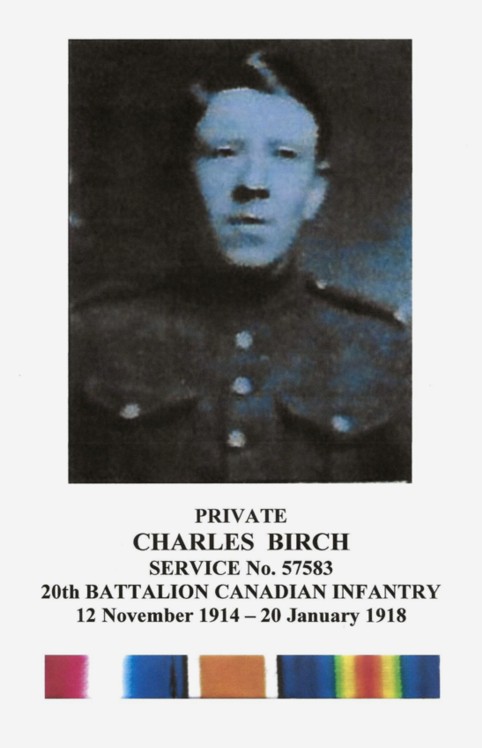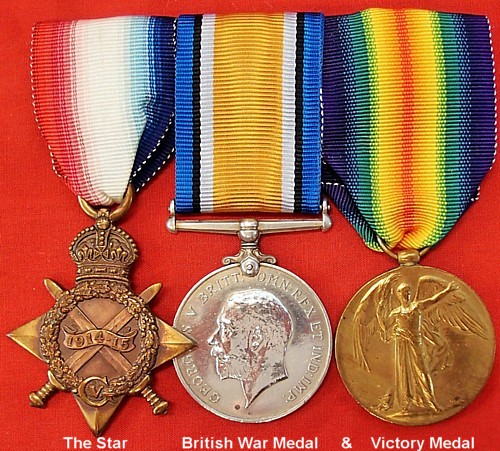
MILITARY HISTORY
PRIVATE CHARLES BIRCH – No. 57583 – Active Service (World War I)
Charles was working as a seaman in the Great lakes when war broke out. He and a friend jumped ship in Parry Sound and encouraged other young men to sign up for military service.
On November 12th, 1914, Charles Birch completed the Attestation Paper for the Canadian Active Service Force (CASF) at Parry Sound, Ontario. He was 24 years old when, and unmarried, he enlisted for the duration of the War. Charles was born in Shrewsbury, Shropshire England and gave his date of birth as May 21, 1890. He listed his present address as Box 481, Parry Sound, Ontario. Charles indicated that he had previous Military experience with 23rd Battalion Militia but he had not served in an Active Formation or Unit of The Canadian Army.
Charles indicated he had previously worked as a bricklayer’s helper. He was described as standing 5 feet 3½ inches with red hair, sandy complexion, and blue eyes.
Private Birch was sent to England with the 20th Battalion Canadian Infantry on June 12th, 1915, and in August 1915 he was sent to France.
France and Flanders
Upon arrival in France on 15 September 1915, the 20th battalion was assigned to the 4th Brigade, 2nd Division, Canadian Corps and given a section of the front on the Ypres Salient, near Messines. Duty holding the line included: nightly patrolling in no man’s land, endless repairs to wire and trenches, and almost continuous enemy shelling. The winter of 1915-16 was spent in a routine of 18 days on the front and 6 days in the rear, all the while battling lice, trench foot, and disease. In March 1916, steel helmets were issued to all ranks.
In the spring of 1916, the Commander of the British Second Army decided that it was essential for an enemy salient near the village of St. Eloi to be eliminated. Following attacks and counterattacks, the 4th Brigade tried to retake the craters that the 6th Brigade was forced to fall back from. The 20th Battalion managed to retake one crater and held it through a month of concentrated shelling. In one month, the 4th Brigade suffered 1373 casualties.
The Somme
On 15 September 1916 the Second Division joined the attack at the Somme, supported by tanks for the first time. The infantry captured three lines of trenches and reached their final objectives in just 40 minutes. The tanks, however, had broken down. Meanwhile, the 20th was trying to consolidate its position despite taking machine gun fire from both flanks.
Early October brought heavy rain and a second attack at the Somme. Under heavy shelling, the 20th captured two lines of trenches in close combat, mainly with grenades and bayonets. In both these actions, the 20th captured all of their objectives and held them until relieved, but at a cost of 111 killed and 319 wounded in only three weeks.
The winter of 1916-1917 was spent holding different parts of the line, patrolling, and carrying out trench raids. One particularly large raid was carried out on the morning of 17 January 1917. On this raid, in 90 minutes, the battalion took 57 prisoners, including one officer, captured one mortar piece, and destroyed 35 deep dugouts, two bomb stores, and two mortar pieces. Two officers and thirty men of the enemy were counted dead, besides an indeterminate number killed inside dugouts. Our casualties were two officers wounded, 27 other ranks killed, 51 wounded and one missing.
Vimy Ridge
Spring of 1917 found the Canadian Corps preparing to take Vimy Ridge as a part of the Battle of Arras. The ridge had been in the hands of the Germans since the early days of the war and provided them with good observation on our rear area, while denying us a view of the wide Douai Plain behind it. The French made an unsuccessful attempt to take the ridge in May 1915. They tried again in September 1915, and this time got as far as the second trench lines. These positions were consolidated by the British but were lost to German counterattacks in May 1916. Vimy was one of the most heavily defended points on the whole Western Front.
The Second Division attacked in the direction of Farbus, on an initial frontage of 1500 yards and a final frontage of 2500 yards. The total depth was 3500 yards. The attack went in on 9 April 1917 with the 4th Brigade right, the 5th Brigade left, and the 6th Brigade and the 13th Imperial Brigade moving through the lead brigades to capture depth objectives.
The 20th Battalion attacked in right depth of the 4th Brigade, mopping up the enemy still holed up in trenches and craters, taking prisoners and collecting maps and documents. During the attack, contact was lost with the 5th Brigade troops on the left, a gap filled by C Company of the 20th. This company also captured a German Field Gun at the entrance to Thélus.
The attack was a complete success. The Canadian Corps captured the entire ridge, a stunning achievement that many in the High Command had declared impossible, but which proved the worth of Canadian troops. Casualties of the 20th Battalion were relatively light, i.e. under one hundred, of whom only six were killed. This was, unfortunately, not true of the Canadian Corps as a whole.
Private Birch was known by his comrades as “Red” Birch due to his red hair. Charles was injured by a concussive shell explosion during the battle of the Somme in 1916, was treated and returned to duty. He was buried alive and injured by another shell explosion in March 1917 during the battle of Vimy Ridge. He was wounded in the nose; nasal cavities and his hearing were impaired because of this injury. While he was still buried at Vimy Ridge, Private Birch was declared killed in action (KIA) and his wife was notified before he dug himself out and was treated for his injuries. It was many weeks before his family back home received the joyful news that he was alive.
Private Birch was operated on in the field hospital and again in hospital at Etaples, France. He was shipped to the Canadian Military Hospital in Liverpool England where he was deemed unfit for further military duty, suffering from deafness and Chronic suppurative otitis media. He was determined to be 100% disabled and returned to Canada from France on July 18th, 1917.
Private Birch remained at the Queens Military hospital until August 13th, 1917. He lists his address as Box 824, Trenton Ontario. He had been in France for 19 months. Private Birch was discharged from service on January 20th, 1918.
Private Birch had served 2 years and 3 months. He was eligible for the Volunteer Service Medal, British War Medal 1914-1920, and the Victory Medal 1914-1919.
Charles Birch died on September 6th, 1968.
An excerpt from an article in McLean’s magazine by Barbara Amiel, September 1996:
The military is the single calling in the world with job specifications that include a commitment to die for your nation. What could be more honorable?

PERSONAL HISTORY
PRIVATE CHARLES BIRCH
Charles Birch was born in Shrewsbury, Shropshire, England on May 21, 1890, son of Thomas Birch and Emily France. His siblings included Henry “Harry”, Lillian “Lily”, Thomas, Mary Jane and Agnes Birch. His two older brothers Harry & Thomas were killed in the Boer War. Charles received his education in England and later worked as a brick layer’s assistant.
In 1914, Charles immigrated to Canada settling in Parry Sound, Ontario. That same year Charles was working on the Lakers, shipping on the Great Lakes when the war broke out. He and a friend jumped ship in Perry Sound and started a recruiting rive for Canadians to join the Army. In November 1914, Charles enlisted to serve his King and new Country. While recovering from injuries sustained at the Somme in 1916, Charles met and married Mary Jane Oakley in Birkenhead, England on November 16, 1916. After almost four years serving in WWI, Charles and Mary Ann returned to Canada settling near Trenton, Ontario. Charles found employment in Pointe Anne working with the Canada Cement Company
They moved to Lakefield around 1928 residing at the home on the northeast corner of Regent and Albert Streets. Charles continued working with the Canada Cement Company in Lakefield. They had a family of seven children – John Phillip “Jack” 4 Dec 1919 – 20 May 1996, Charles Joseph “Chuck” 28 Jul 1921 – 15 Mar 1997, Mary “Noreen” 23 Sep 1923 – 23 Sep 2005, George William Vincent – 28 Oct 1925 – 13 Nov 2012, Mavis LaFerne 18 Mar 1928 – 13 Mar 2005, Thomas Herbert – 7 May 1930 – 12 Jan 2022 & Betty Kathleen Birch 20 Aug 1931. In 1930 sadly the Canada Cement Company folded and Charles was out of work. In order to feed his family, Charles travelled by foot looking for work and was often gone for days.
When World War II broke out, the two oldest sons of Charles, Jack and Chuck enlisted to serve and went overseas. Charles desperately wanted to go with them. To do his part and serve his country, Charles joined the Home Guard and worked in Thunder Bay as a prison guard. His son George joined the Navy but never went overseas and his daughter Noreen was a member of the Canadian Women’s Army Corp and was also stationed in Canada. Charles was a member of the Royal Canadian Legion Branch #77 in Lakefield for forty years.
Charles passed away on September 6, 1968 and Mary Jane died on February 26, 1978; both are buried in Hillside Cemetery in Lakefield, ON
Charles Birch is remembered with honour on a framed document which hangs in the St. John the Baptist Anglican Church in Lakefield.
